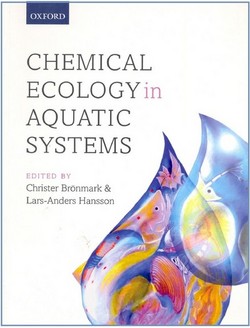Chemical Ecology in Aquatic Systems
By
Christer Bronmark
Lars- Anders Hansson
In recent years it has become increasingly clear that chemical interactions play a fundamental role in aquatic habitats and have far-reaching evolutionary and ecological consequences. A plethora of studies have shown that aquatic organisms from most taxa and functional groups respond to minute concentrations of chemical substances released by other organisms. However, our knowledge of this “chemical network” is still negligible. Chemical interactions can be divided into two larger sub-areas based on the function of the chemical substance. First, there are interactions where chemical substances are toxic to other organisms and are used as a defence against consumers (including both herbivores and predators) or a weapon against competitors (allelopathy). Second, chemical substances may be used as a source for information of the environment; for example: how can I find the optimal habitat, the best food, the nicest partner, and avoid being eaten? Aquatic organisms are able to detect and respond to extremely low concentrations of chemical cues to answer all these questions. The book aims at connecting these intriguing chemical interactions with traditional knowledge of organism interactions.
Chemical Ecology in Aquatic Systems covers a wide range of studies, both plant and animal, from different geographic regions and habitats – pelagic as well as benthic. Most of the chemical interactions are similar in freshwater and marine habitats and this book therefore strives at integrating work on both systems. This accessible, research-level text is aimed at graduate students and professional researchers in the fields of limnology, marine ecology, evolutionary biology, behavioural ecology, and chemical ecology.
Contents:
- Aquatic odour dispersal fields: opportunities and limits of detection, communication, and navigation.
- Information conveyed by chemical cues.
- Pheromones mediating sex and dominance in aquatic animals.
- Chemical signals and kin biased behavior.
- The use of chemical cues in habitat recognition and settlement.
- Migration and navigation.
- Death from downstream: chemosensory navigation and predator – prey processes.
- The taste of predation and the defences of prey.
- The evolution of alarm substances and disturbance cues in aquatic animals.
- Scaling up infochemicals: ecological consequences of chemosensory assessment of predation risk.
- Neuroecology of predator – prey interactions.
- Why is the jack of all trades a master of none? Studying the evolution of inducible defences in aquatic systems.
- How to explore the sometimes unusual chemistry of aquatic defence chemicals.
- Allelochemical interactions among aquatic primary producers.
- Chemical defences against herbivores.
- Chemical defences against predators.
- Infodisruption: pollutants interfering with the natural chemical information conveyance in aquatic systems.
- Aquatic chemical ecology: new directions and challenges for the future.




ساحة النقاش